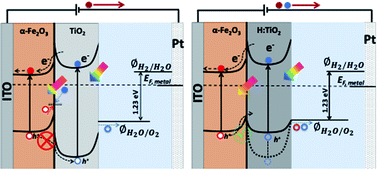Hydrogen induced interface engineering in Fe2O3–TiO2 heterostructures for efficient charge separation for solar-driven water oxidation in photoelectrochemical cells†
Abstract
Semiconductor heterostructure junctions are known to improve the water oxidation performance in photoelectrochemical (PEC) cells. Depending on the semiconductor materials involved, different kinds of junctions can appear, for instance, type II band alignment where the conduction and valence bands of the semiconductor materials are staggered with respect to each other. This band alignment allows for a charge separation of the photogenerated electron–hole pairs, where the holes will go from low-to-high valance band levels and vice versa for the electrons. For this reason, interface engineering has attracted intensive attention in recent years. In this work, a simplified model of the Fe2O3–TiO2 heterostructure was investigated via first-principles calculations. The results show that Fe2O3–TiO2 produces a type I band alignment in the heterojunction, which is detrimental to the water oxidation reaction. However, the results also show that interstitial hydrogens are energetically allowed in TiO2 and that they introduce states above the valance band, which can assist in the transfer of holes through the TiO2 layer. In response, well-defined planar Fe2O3–TiO2 heterostructures were manufactured, and measurements confirm the formation of a type I band alignment in the case of Fe2O3–TiO2, with very low photocurrent density as a result. However, once TiO2 was subjected to hydrogen treatment, there was a nine times higher photocurrent density at 1.50 V vs. the reversible hydrogen electrode under 1 sun illumination as compared to the original heterostructured photoanode. Via optical absorption, XPS analysis, and (photo)electrochemical measurements, it is clear that hydrogen treated TiO2 results in a type II band alignment in the Fe2O3–H:TiO2 heterostructure. This work is an example of how hydrogen doping in TiO2 can tailor the band alignment in TiO2–Fe2O3 heterostructures. As such, it provides valuable insights for the further development of similar material combinations.

- This article is part of the themed collection: Solar energy


 Please wait while we load your content...
Please wait while we load your content...